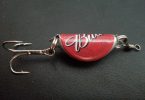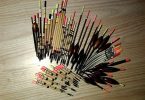I’ve always tied my own hooks. That way, I know exactly the quality and attributes of the hooklength.
Pre-tying hooks means less fumbling around at the bankside, especially when my tiny fingers are frozen.
The problem then has been keeping the pre-tied hooks tidy, and the hooklength unkinked.
I started by wrapping the lengths around small pieces of cardboard, with slits cut into each end, and the hook size and line details written on the card. When full, this would be inserted into a plastic envelope.
Tidy though this was, it meant that the ‘memory’ of the hooklength also meant kinked lengths.
Next, and more successfully, I purchased a quantity of those resealable small plastic wallets, and dropped the tied hooklengths individually into its own wallet, lightly coiled.
The wallets were then kept in packets, again with a piece of card giving the details. This system served me well for quite a number of years. I still wasn’t totally happy with the slight tendency of the hooklengths to curl, but they were at least as good as shop bought pre-tied hooklengths.
Then I made acquaintance with mullet!
It’s been my experience that these fish test every aspect of an angler’s skill, especially bait presentation.
There is nothing more frustrating than having a large mullet, maybe after several biteless hours, happily swimming around, mopping up free offerings, then confidently swimming up to your baited hook, mouth agape, only to have it swirl away, the very second that it’s lips (crammed with sensors) touches your bait.
There are many things which could be responsible for giving the game away; perhaps the taste of finger oils where you squeezed the bread to the shank of the hook, the way the bread hangs unnaturally in the tide, tethered to your line. Or perhaps the electrical field of the buried hook, maybe the glinting of the line.
When Rob Ness presented me with a length of new fluorocarbon line, it was a revelation.
Try suspending a weighted length of this line, in a glass of crystal clear water, together with a mono line of similar diameter.
Fluorocarbon, possessing almost the same refraction index of water, practically disappears.
Now look what happens when you remove the weight, the fluorocarbon coils.
Still less visible than the mono, the coiling of the line reveals its presence. Light from above reflects from the surface of the coils. This line (in fact any line) needs to be presented so that it hangs straight down to the bait.
Although it retains ‘memory’ of its coiling onto the spool, it was Rob Ness again who told me that hanging it in the steam of a kettle, will straighten it out.
Fine, but how to store the straightened line conveniently in the ‘oft shuffled chaos of my tackle bag without it re-kinking or re-coiling?
A large sheet of cardboard, or perhaps wood, seemed to be the obvious answer. But that was going to be bulky and a bit of a nuisance.
Then I thought of the cheap, but highly effective lure-guards that Nick Buss had put me on to.
A length of 15mm foam pipe insulation costs next to nothing, Chopped into small sections, these make ideal lure guards, allowing you to chuck handfuls of lures into your pockets, without them becoming tangled, and to retrieve them with little risk of pricking your hands.

The thought came into my mind, suppose I were to cut a length of insulation tubing, equal to the length of the hooklengths I was going to use? I could bury the hook into the foam and leave the straightened hooklength inside the tube!
In fact, when I tried it out, I found that it’s best to tie the hook (remember, if you are use eyed hooks to pass the line through the eye from the front, not the back • you get better hooking that way) then lower the tied hook down through the tube, until it emerges at the other end.
After hooking the hook into the foam, the hooklength can be trimmed to the correct length, then trapped beneath a rubber band at the other end.

When you need a new hook, you simply unhook the hook from the foam, and gently pull the line through the tube • simple!
You can keep different tubes for each hooksize, or use a felt tip pen to mark the end where you impale the hooks into (say) 4 sections, writing the hook size on each section.
Now, all I have to do is to decide whether to make my fortune by patenting the idea, or just to share it with all my mates at Anglersnet J
Tight Lines • Leon Roskilly
PS The hooks I’ll be using for mullet will be painted white, to hide them against the whiteness of the bread.
If you are going to fish for mullet, please be sure to return them alive. These long lived fish don’t spawn until around 10 years old (when they will be a little over 3lb or so), then they will possibly spawn only one year in every three. Unless we conserve these wary, hardfighting fish, there are those of us who will greatly miss them in the years to come.








